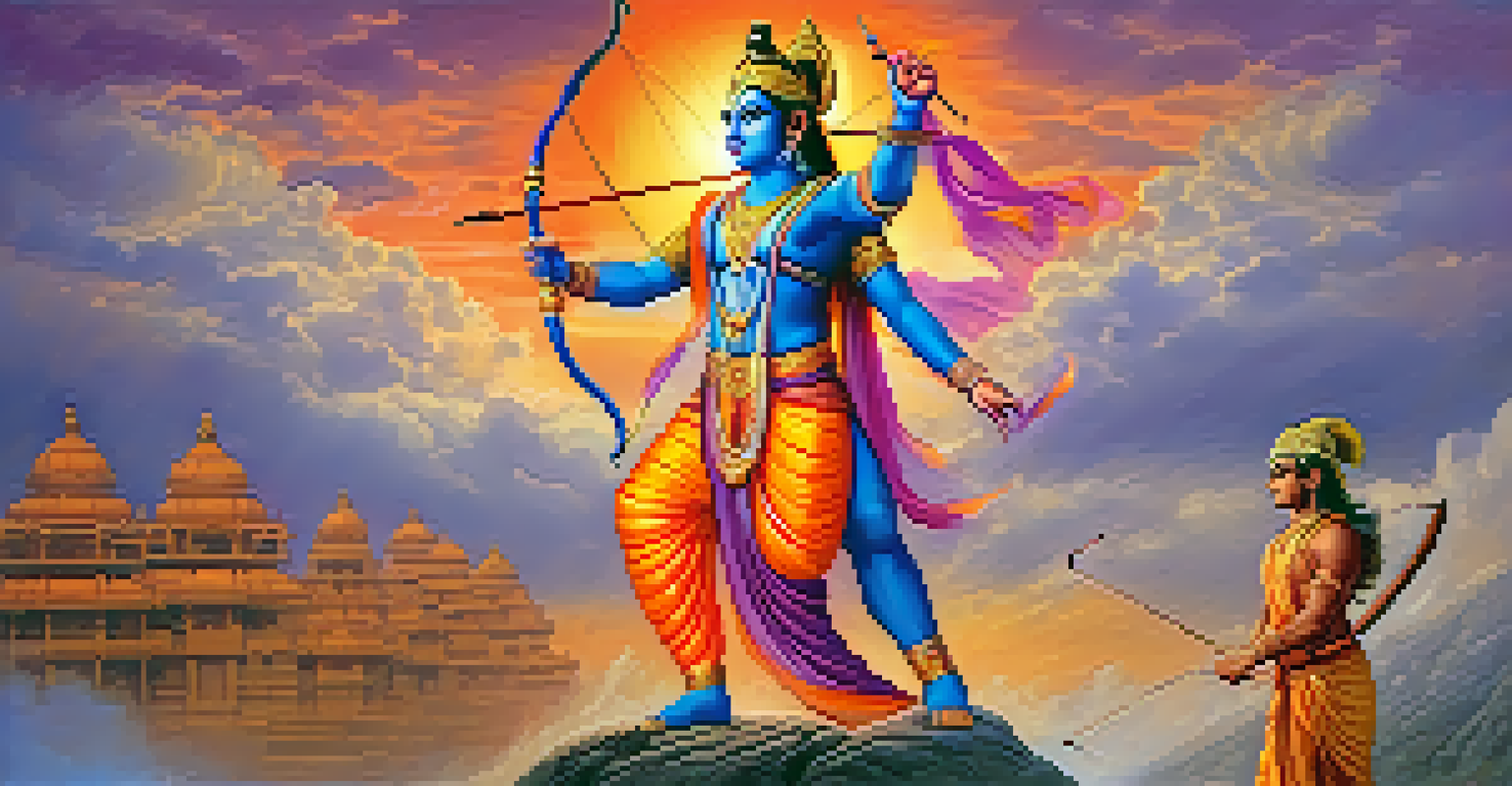The Spiritual Trail of the Ramayana: A Journey to the Divine

Understanding the Ramayana: A Sacred Epic
The Ramayana is not just a story; it’s a spiritual epic that has shaped the cultural and moral fabric of India. Authored by the sage Valmiki, it narrates the life of Lord Rama, his quest to rescue his wife Sita, and the eternal battle between good and evil. This epic serves as a guide, offering profound lessons on dharma (righteousness) and devotion.
The Ramayana teaches us that righteousness is the foundation of a meaningful life.
At its core, the Ramayana is about more than just historical events; it embodies the spiritual journey of its characters. Each character represents different aspects of life and virtues we can aspire to, such as courage, loyalty, and love. The narrative encourages readers to reflect on their own lives while drawing inspiration from Rama's journey.
As we delve deeper into the Ramayana, we discover that it is a timeless tale that transcends geographical boundaries. Its teachings resonate with people across cultures, making it a universal spiritual guide. Understanding this epic's essence sets the foundation for exploring its spiritual trail.
The Pilgrimage of the Ramayana: Sacred Sites
The journey of the Ramayana is not only a literary one but also a physical pilgrimage through various sacred sites in India and beyond. Key locations such as Ayodhya, where Rama was born, and Rishikesh, where Sita and Rama spent time, are steeped in spiritual significance. Visiting these places allows devotees to connect with the timeless teachings of the Ramayana.

Each site along this spiritual trail offers unique experiences and lessons. For instance, the banks of the Ganges in Rishikesh are perfect for meditation, helping pilgrims reflect on the inner journey alongside the external one. These locations serve as reminders of the virtues exemplified by Rama and his companions.
Ramayana: A Guide to Dharma
The Ramayana emphasizes the importance of dharma, teaching us through its characters the significance of ethical choices and personal responsibilities.
As travelers embark on this pilgrimage, they not only honor the legacy of the Ramayana but also engage in self-discovery. Walking in the footsteps of Rama enables a deeper understanding of his teachings and an opportunity for personal growth through spirituality.
Key Lessons from the Ramayana: Morality and Dharma
One of the most striking aspects of the Ramayana is its emphasis on dharma, or duty. Rama, the protagonist, embodies the ideal man who adheres to his responsibilities, even in the face of adversity. This highlights the importance of making ethical choices, reminding us that our actions have consequences that extend beyond ourselves.
Devotion is not just an act of worship; it is a way of embodying love for the divine.
The various characters in the Ramayana illustrate different aspects of morality. For instance, Sita's unwavering devotion to Rama and Hanuman's loyalty serve as powerful examples of love and faith. These stories provide valuable lessons on integrity, highlighting that true strength lies in maintaining one's values.
By exploring these moral lessons, we can apply them to our daily lives. The Ramayana encourages us to strive for righteousness and remain steadfast in our commitments, ultimately guiding us toward a more fulfilling and ethical existence.
The Role of Devotion: Bhakti in the Ramayana
Devotion, or bhakti, is a central theme in the Ramayana, showcasing the importance of surrendering to the divine will. Characters like Hanuman exemplify this through their unwavering faith in Rama. This devotion is not just about worship; it embodies a deep connection and love for the divine, inspiring followers to cultivate their spiritual practice.
The Ramayana illustrates that bhakti can manifest in various forms, from prayer and chanting to selfless service. Hanuman's dedication to Rama serves as a profound example of how devotion can empower individuals to overcome obstacles. Such teachings encourage devotees to develop a personal relationship with the divine.
Devotion: The Heart of Spirituality
The theme of bhakti in the Ramayana illustrates the transformative power of devotion, encouraging followers to cultivate a personal relationship with the divine.
In fostering devotion, the Ramayana reminds us that spirituality is a journey of the heart. Engaging with these teachings allows us to deepen our connection with the divine and enrich our spiritual lives through love and surrender.
The Symbolism of Characters: Lessons in Humanity
The characters in the Ramayana are rich with symbolism, each representing different facets of humanity. Rama symbolizes righteousness, while Sita embodies purity and strength. These characters serve as mirrors, reflecting our own struggles and aspirations, making the epic relatable and timeless.
Villains like Ravana also play a crucial role in the narrative, representing the darker aspects of human nature. His character serves as a cautionary tale about pride and ambition run amok, reminding us of the importance of humility and self-awareness. Understanding these characters helps us navigate our complexities as individuals.
By analyzing these symbolic figures, we can glean profound insights into our own lives. The Ramayana encourages us to reflect on our choices and behaviors, allowing us to strive for growth and balance in our personal journeys.
The Nature of Good vs. Evil: A Universal Conflict
At its heart, the Ramayana explores the timeless battle between good and evil, a theme that resonates across cultures and generations. This epic portrays the struggle between righteous forces, represented by Rama, and the malevolent ones, embodied by Ravana. The narrative emphasizes that this conflict is not just external but also internal, reflecting our own moral dilemmas.
The triumph of good over evil in the Ramayana serves as a powerful reminder that righteousness will ultimately prevail. Through trials and tribulations, Rama's unwavering commitment to dharma illustrates that even in the darkest times, hope and virtue can emerge victorious. This message offers encouragement in our own struggles against adversity.
Good vs. Evil: A Universal Theme
The epic's exploration of the conflict between good and evil serves as a timeless reminder of the internal and external struggles we all face in life.
Understanding this universal conflict allows us to comprehend the complexities of human nature. The Ramayana invites us to engage in self-reflection and recognize the dualities within ourselves, encouraging us to choose the path of righteousness.
The Ramayana's Influence on Art and Culture
The Ramayana has had a profound impact on art, literature, and culture throughout history. From classical dance forms like Bharatanatyam to modern adaptations in film and literature, its narratives continue to inspire creative expressions. This ongoing influence highlights the epic's relevance and adaptability across various mediums.
The stories of the Ramayana have been retold in countless ways, allowing new generations to connect with its teachings. Artists, writers, and performers draw from its rich characters and themes, creating works that resonate with contemporary audiences. This cultural evolution of the Ramayana enriches our understanding and appreciation of its wisdom.

By exploring the Ramayana's influence on art, we see how deeply intertwined spirituality and creativity can be. Engaging with these artistic interpretations allows us to experience the epic's teachings in new and imaginative ways, fostering a deeper connection to its timeless messages.